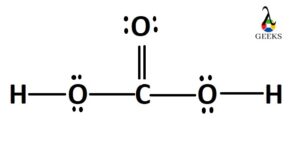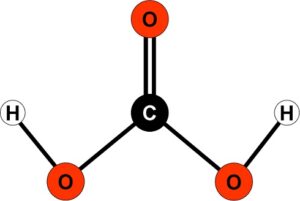In this article, “carbonic acid lewis structure”, lewis structure drawing of carbonic acid and relevant detailed explanations are discussed briefly.
Carbonic acid is a weak acid consisting two types of ions, hydrogen ion (H+) and carbonate ion (CO32-). Hydrogen, carbon and oxygen have 1, 6 and 8 electrons respectively. Among them, only the valance and nonbonded electrons are shown around the respective atoms.
Definition, methods of drawing lewis structure with formal charge calculation and carbonic acid lewis structure are the main focus of this article.
What is Lewis Structure?
Lewis structure also known as lewis dot structure is one type of special structural representation of any molecular species, in which valance electrons are basically showed around the respective atoms along with bonds (ionic and covalent) involved in that particular molecule.
This special type of representation was first introduced by great scientist Gilbert. N. Lewis through his article named as “The Atom and the Molecule” in the year of 1916.
Lewis dot structure has a vast significance in inorganic chemistry. Total number of electrons that does not participate in bonding can be easily determined from lewis dot structure and number of valance electrons can also be calculated from the skeletal structure of lewis dot structure. This new concept also gives a way out of calculating formal charge of each of the atom present in that particular molecule.
Methods of Drawing Lewis Structure
There are some points explained below that should be kept in mind to draw the lewis dot structure-
- As valance electrons have a significant role in drawing lewis dot structure so outer most shell electrons must be identified and counted first to proceed into further steps.
- The valance shell of most of the atoms other than noble gas are not fulfilled with electrons. They need a particular number of electrons to get fulfilled in their valance shell and achieve the noble gas electron configuration. This is called octet rule up to the atoms reside in 2nd period.
- Now the next step is to calculate the total number electrons participate in covalent or ionic bond confirmation.
- These are the main parameters that should be determined first to draw the lewis dot skeletal structure of any molecule.

Image Credit: Wikimedia Commons.
In the above lewis structure of HOBr, nonbonding electrons of oxygen and bromine are shown around them. Oxygen has eight electrons with six valance electrons and bromine has seven valance electrons. Among them, two electrons from oxygen are involved in bond formation with hydrogen and bromine.
Among the seven outer most shell electrons in bromine, only one electron participates in covalent bond formation with oxygen. Rest of the six electrons remain as nonbonded electron pairs.
Hydrogen has only one electron and it is used in covalent bond formation with oxygen. Thus, no electrons are left as nonbonded electrons.
Read more about BI3 Lewis Structure
Carbonic Acid Lewis Structure
Carbonic acid is a weak dibasic acid with a chemical formula H2CO3. It is prepared from the reaction between carbon dioxide (CO2) and water (H2O) having molar mass 62.03 g/mol and melting point -800 C.

Hydrogen, carbon and oxygen are three atoms present in carbonic acid. Carbon is the central atom and has atomic number six (1s2 2s2 2p2). Among these six electrons, four electrons occupy the valance shell (valance electrons). Carbon uses its four valance shell electrons in covalent bond formations. Thus, no electrons are left as nonbonding electron pairs.
In oxygen, six electrons are outer most shell electrons out of total eight electrons. Among these six electrons, two electrons are involved in bond formation with hydrogen and carbon (one single bond with hydrogen and another covalent bond with carbon). Rest of the four electrons are shown as nonbonding electron pairs around oxygen atom.
At last hydrogen has only one electron as well as one valance shell electrons. This one electron is used to form the covalent bond with oxygen and there is no electron as nonbonding electron.
Formal Charge Calculation of Carbonic Acid
One of the significant roles of lewis structure as formal charge can be calculated from this structural representation.

Image Credit: Wikimedia Commons
- Formal charge = Total number of valance electrons – number of electrons remain as nonbonded – (number of electrons involved in bond formation/2)
- Formal charge of central atom, carbon = 4 – 0 – (8/2) = 0
- Formal charge of oxygen doubly bonded with carbon atom = 6 – 4 – (4/2) = 0
- Formal charge of oxygen attached by single bond with carbon and hydrogen = 6 – 4 – (4/2) = 0
- Formal charge of hydrogen = 1 – 0 – (2/2) = 0
From the formal charge calculation of each atom in carbonic acid, it is concluded that carbonic acid is a neutral molecule.
Frequently Asked Questions (FAQ)
Is carbonic acid dissolved in water?
Answer: Yes, carbonic acid is dissolved in water. It dissociates in aqueous solution and form H+ ion and bicarbonate ion (HCO3–).
What are the uses of carbonic acid?
Answer: Carbonic acid has different uses in different field like it is used in preparing of soft drinks and other beverages. Besides that, it is one of the important elements of blood which conveys carbon dioxide out of the body.
Also Read:
- Ncl2 lewis structure
- Sbcl5 lewis structure
- Icl3 lewis structure
- Clcn lewis structure
- Alh3 lewis structure
- Ch3f lewis structure
- Cl2o lewis structure
- Hbr lewis structure
- Clo3 lewis structure
- Xecl4 lewis structure

Hello,
I am Aditi Ray, a chemistry SME on this platform. I have completed graduation in Chemistry from the University of Calcutta and post graduation from Techno India University with a specialization in Inorganic Chemistry. I am very happy to be a part of the Lambdageeks family and I would like to explain the subject in a simplistic way.
Let’s connect through LinkedIn-https://www.linkedin.com/in/aditi-ray-a7a946202